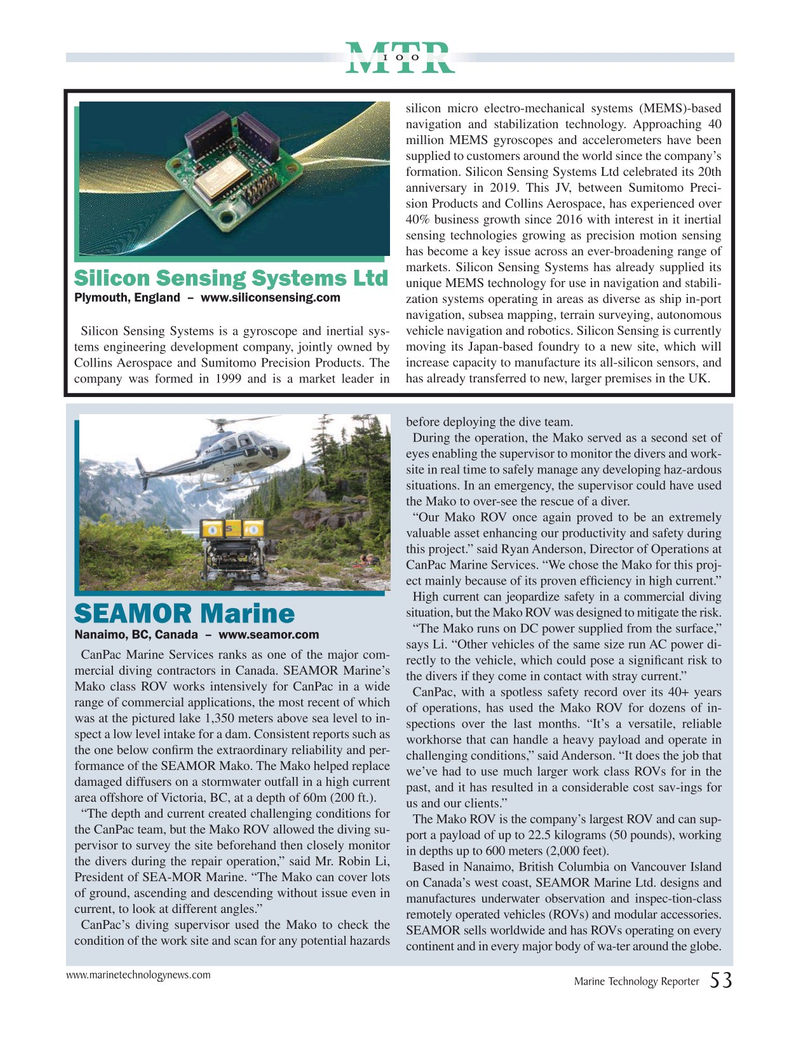
Page 53: of Marine Technology Magazine (July 2020)
Read this page in Pdf, Flash or Html5 edition of July 2020 Marine Technology Magazine
100
MTRMTR silicon micro electro-mechanical systems (MEMS)-based navigation and stabilization technology. Approaching 40 million MEMS gyroscopes and accelerometers have been supplied to customers around the world since the company’s formation. Silicon Sensing Systems Ltd celebrated its 20th anniversary in 2019. This JV, between Sumitomo Preci- sion Products and Collins Aerospace, has experienced over 40% business growth since 2016 with interest in it inertial sensing technologies growing as precision motion sensing has become a key issue across an ever-broadening range of markets. Silicon Sensing Systems has already supplied its
Silicon Sensing Systems Ltd unique MEMS technology for use in navigation and stabili-
Plymouth, England – www.siliconsensing.com zation systems operating in areas as diverse as ship in-port navigation, subsea mapping, terrain surveying, autonomous
Silicon Sensing Systems is a gyroscope and inertial sys- vehicle navigation and robotics. Silicon Sensing is currently tems engineering development company, jointly owned by moving its Japan-based foundry to a new site, which will
Collins Aerospace and Sumitomo Precision Products. The increase capacity to manufacture its all-silicon sensors, and company was formed in 1999 and is a market leader in has already transferred to new, larger premises in the UK.
before deploying the dive team.
During the operation, the Mako served as a second set of eyes enabling the supervisor to monitor the divers and work- site in real time to safely manage any developing haz-ardous situations. In an emergency, the supervisor could have used the Mako to over-see the rescue of a diver.
“Our Mako ROV once again proved to be an extremely valuable asset enhancing our productivity and safety during this project.” said Ryan Anderson, Director of Operations at
CanPac Marine Services. “We chose the Mako for this proj- ect mainly because of its proven ef? ciency in high current.”
High current can jeopardize safety in a commercial diving situation, but the Mako ROV was designed to mitigate the risk.
SEAMOR Marine “The Mako runs on DC power supplied from the surface,”
Nanaimo, BC, Canada – www.seamor.com says Li. “Other vehicles of the same size run AC power di-
CanPac Marine Services ranks as one of the major com- rectly to the vehicle, which could pose a signi? cant risk to mercial diving contractors in Canada. SEAMOR Marine’s the divers if they come in contact with stray current.”
Mako class ROV works intensively for CanPac in a wide
CanPac, with a spotless safety record over its 40+ years range of commercial applications, the most recent of which of operations, has used the Mako ROV for dozens of in- was at the pictured lake 1,350 meters above sea level to in- spections over the last months. “It’s a versatile, reliable spect a low level intake for a dam. Consistent reports such as workhorse that can handle a heavy payload and operate in the one below con? rm the extraordinary reliability and per- challenging conditions,” said Anderson. “It does the job that formance of the SEAMOR Mako. The Mako helped replace we’ve had to use much larger work class ROVs for in the damaged diffusers on a stormwater outfall in a high current past, and it has resulted in a considerable cost sav-ings for area offshore of Victoria, BC, at a depth of 60m (200 ft.).
us and our clients.” “The depth and current created challenging conditions for
The Mako ROV is the company’s largest ROV and can sup- the CanPac team, but the Mako ROV allowed the diving su- port a payload of up to 22.5 kilograms (50 pounds), working pervisor to survey the site beforehand then closely monitor in depths up to 600 meters (2,000 feet). the divers during the repair operation,” said Mr. Robin Li,
Based in Nanaimo, British Columbia on Vancouver Island
President of SEA-MOR Marine. “The Mako can cover lots on Canada’s west coast, SEAMOR Marine Ltd. designs and of ground, ascending and descending without issue even in manufactures underwater observation and inspec-tion-class current, to look at different angles.” remotely operated vehicles (ROVs) and modular accessories.
CanPac’s diving supervisor used the Mako to check the SEAMOR sells worldwide and has ROVs operating on every condition of the work site and scan for any potential hazards continent and in every major body of wa-ter around the globe.
www.marinetechnologynews.com
Marine Technology Reporter 53
MTR #6 (50-63).indd 53 8/13/2020 9:34:41 AM

 52
52

 54
54
